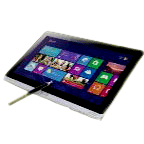Q. What is Hardware ?
A.Hardware is nothing but a collection of components, which is taking data from the user and doing the process and get the results in the output.
The major components of a digital computer are shown in the following block diagram. They are CPU, memory,input devices and output devices. The input and output devices are also called as computer peripherals of a computer.
1. CPU
The major components of a digital computer are shown in the following block diagram. They are CPU, memory,input devices and output devices. The input and output devices are also called as computer peripherals of a computer.
- It accepts the data or instructions by the way of input.
- It stores the data in the memory unit.
- It can process the data as required by the user.
- It gives results in the form of output .
- It controls all operation inside a computer.
 |
| Block Diagram of a computer |
CPU means Central Processing Unit. The CPU is consider as a heart of a computer which can do the any operations easily given by the user and without CPU no operations cannot be done. The primary function of a CPU is to be execute the programs.
The CPU again contains sub units . They are :-
1. Control Unit (CU)
2. Arithmetic & Logical Unit (ALU)
3. Memory Unit (Registers)
- Control unit generates the timing and control signals that are necessary to execute the instructions. It can control the entire operations of a computer.
- The function of an ALU is to perform the arithmetic operations such as Additions, Subtraction, Multiplication & Division. It can also perform the certain the logical operations such as AND, OR, NOT, EXCLUSIVE OR.
- Registers are used to store the temporary memory results and data while performing certain operations.
The main purpose of memory is to store the information. Basically the memory are 2 types of memory is used in a computer. They are :
a) Primary memory or main memory.
b) Secondary memory or auxiliary memory.
- Primary memory is volatile in nature i.e the information stored on primary memory will be lost when the computer is switched off.
- The information written to a hard disk is permanent .
- TO improve the performance of the computer several other memories are used such as as cache memory, virtual memory etc.
- Semiconductor memory
- Magnetic memory
Magnetic memory is slower but cheaper when compared to semiconductor memory. It is used as secondary memory and backup for mass storage of information.
Ex:- RAM, ROM, EPROM are examples for semiconductor memory.
Ex:- Hard disk, floppy disk, tape are examples for magnetic memory.
3. Input devices
A information is entered into the computer through input devices. An input device converts input information into suitable binary from acceptable to a computer. One commonly used input device is keyboard. Other input devices include mouse, joystick, light pen, touch screen, track balls etc., Now a days voice input systems are also have been developed.
4. Output devices
Output devices receive results and other information from the computer and provides them to the users.The computer usually sends the information in the form of binary coded representation. Then output device converts it into user understandable and provides the output to the users.

Computer Hardware Information - Computers have two main parts:- Software and hardware. Software is made up of code which translates into a series of instructions that tell the computer what to do. Computer hardware refers to physical and tangible parts of the computer that are visible and can be touched.
ReplyDeleteAll computer systems ranging from desktop and laptop to smartphones have the following computer hardware in all their system:- primary storage or RAM, secondary storage (ROM), input devices (keyboard, mouse, touchscreen, camera, and microphones), and output device (screen and printers). For more visit: computermobile.info